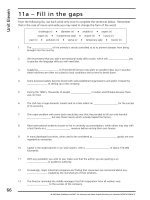Mastering the marterial 6 potx
Bạn đang xem bản rút gọn của tài liệu. Xem và tải ngay bản đầy đủ của tài liệu tại đây (76.23 KB, 6 trang )
BE A COPY CAT
If you are learning something complex from a pamphlet or book,
choose a few paragraphs you feel are most challenging. Copy them
exactly, and then read them out loud. Copy them a second time, and
then read them aloud again. Copy a third time; read aloud a third
time. This really works!
MAPPING AND DOODLING
Mapping and doodling are visual ways to take notes. You can map or
doodle information about anything you are studying, whether you are
in a classroom listening to a lecture or sitting in the library reading. If
you enjoy visualizing, this is a good study strategy for you because the
process of drawing a map or doodling a picture can make relationships
between topics become clearly visible.
The good news is that you don’t have to be an artist to doodle or
draw an effective map of information. The process is really straight-
forward.
Mapping
In the middle of a clean piece of paper, write down the main point,
idea, or topic under consideration. Draw a circle around this main
topic. Next, draw branches out from the circle on which you can
record subtopics and details. Create as many branches as you
need—or as many as will fit on your sheet of paper. The figure on
page 110 is an example of a simple map; it has only one level of sub-
headings.
The level of detail you will include on each map depends on what
you want to remember. Perhaps you already know part of a subject
thoroughly but can’t seem to remember any details about one or two
particular subtopics. In that case, you can tailor the map to fit your
needs. Consider Nadya, who has studied the seven major United
States Civil War battles in the figure on page 110. She is very famil-
iar with five of them: Gettysburg, Shiloh, Fredericksburg, Manassas,
and Vicksburg. However, she is having trouble remembering two of
them, Antietam and Cold Harbor. The figure on page 111 shows
Nadya’s map, which includes all seven major battles of the Civil War;
in addition, her map includes specific details about the two battles
that she has trouble recalling.
Mastering the Materials
109
Mapping information forces you to organize the information you
are studying, whether that information is from your class notes, a
lecture, a field trip, or a textbook. Sometimes you will need to spend
considerable time coming up with an appropriate word, phrase, or
sentence to write in the center circle of a map. Then you may need to
spend even more time considering which topics are related to that
main topic for the next level of branches. This process of making deci-
sions and bridging connections between ideas and facts makes drawing
maps an effective study strategy.
Doodling
Doodling, or scribbling notes and pictures, can reflect the speaker’s
words in a way that will help you absorb a concept, such as a chemi-
cal change, or relationships, such as how the various characters in
Shakespeare’s A Midsummer Night’s Dream interact.
A further benefit of these graphic strategies is that you end up with
an excellent review aid. Because the material is organized in a visual
110
10 SECRETS TO ACING ANY HIGH SCHOOL TEST
Major United States
Civil War Battles
Gettysburg
Manassas
Cold Harbor
Vicksburg
Shiloh
Antietam
Fredericksburg
way, you may recall the information more readily each time you
review it. It gives the material you are mastering a definite structure,
a visual language.
OUTLINING
Outlining is another visual study tool that displays layers of informa-
tion and how they work together to support the overall main idea.
Mastering the Materials
111
Major United States
Civil War Battles
Gettysburg
Manassas
Cold Harbor
Vicksburg
Shiloh
Antietam
Fredericksburg
Virginia
June 3, 1864
Casualties
7,000 North
1,500 South
What Happened?
Lee was ill
Many were
shell-shocked
South had many
lines of trenches
Grant regretted
ordering attack
Only time Grant
admitted he was
wrong
He never
ordered
another
similar attack
Maryland
September 17, 1862
Name of battle
South—Sharpsburg
(name of village)
North—Antietam
(name of river)
Casualties
6,000 killed
17,000 wounded
Four times the
casualties of
Normandy Beach,
June 1944
What Happened?
North barely won
Kept South from
gaining England’s
support
North had poor
generalship
The outlining strategy is similar to the rewriting-your-notes strat-
egy. The main difference is that outlines are more formal and more
structured than notes. That is, there is a certain way in which outlines
should be organized. In an outline, you can see exactly how support-
ing material is related to main ideas.
The basic structure for an outline is this:
1. Topic
A. Main Idea
1. Major supporting idea
a. Minor supporting idea
Outlines can have many layers and many variations, but this is essen-
tially how they work: You start with the topic, move to the main idea,
add the major supporting idea, and then list minor supporting ideas (if
they seem important enough to write down). Here is an example of a
partially completed outline based on material in the map:
1. Major United States Civil War Battles
A. Antietam
1. Maryland
2. September 17, 1862
3. Name of Battle
a. South—Sharpsburg (name of village)
b. North—Antietam (name of river)
4. Casualties
a. 6,000 killed; 17,000 wounded
b. Four times the casualties of Normandy Beach, June
1944
5. What happened?
a. North barely won
b. Kept South from gaining England’s support
c. North had poor generalship
B. Cold Harbor
1. Virginia
2. June 3, 1864
112
10 SECRETS TO ACING ANY HIGH SCHOOL TEST
3. Casualties
a. 7,000 Northerners
b. 1,500 Southerners
4. What happened?
a. Lee was ill
b. Many were shell-shocked
c. South had many lines of trenches
d. Grant regretted ordering attack
1. Only time Grant admitted he was wrong
2. Never ordered another similar attack
C. Fredericksburg
D. Gettysburg
E. Manassas
F. Shiloh
G. Vicksburg
CATEGORIZING
Let’s imagine that Janet has a lengthy list to learn for her geography
class: the countries of Africa. She decides to categorize—or separate
the list into smaller lists, each recognized by a common trait—to
make the task more manageable. Janet might organize the nations
into these categories:
•
geographical sections of Africa
•
former colonial status (French, British, Dutch, Belgian, other)
•
dates of independence
It is much easier to memorize several small lists than one large
one. Organization of information is the key to a large task such as
this one.
CREATING YOUR OWN MATERIALS
Here is a list of materials to help you study.
Mastering the Materials
113
Timelines
In a world history class, for example, you could put large sheets of
paper on your bedroom wall to begin timelines. Because you are
studying different countries during similar time periods, you could
write each country’s timeline in a different color. Use the same colors
to make notes of events and people in those countries. Or maybe des-
ignate a different color for each era—that way you could keep track of
what was happening when. If you are using parallel tapes (audio tapes
used for similar purposes), categorize them by having one tape for
each country or one for each century.
Flashcards
Flashcards or cue cards are a popular learning aid. You can get a bit
creative with them. Lucia uses different-sized index cards for differ-
ent subjects: 4 ϫ 6 for science topics and 3 ϫ 5 cards for math.
Roberta has different colored index cards for various topics, and
Timmy writes subcategories in various colored markers. The beauty
of index cards is that they are very portable; you can carry them with
you throughout the day in your backpack or purse.
Here is an example of a cue card.
Front of Card Back of Card
Audio Recording
If one of your learning styles is auditory, try making audiocassettes
or CDs on a recording device. Perhaps you want to record a lecture
or simply talk to yourself about new information you are studying,
recording your observations and connections.
Two of the main advantages of using cassettes or CDs for reviewing
material is that they can be portable and private if you have the right
114
10 SECRETS TO ACING ANY HIGH SCHOOL TEST
the four basic types of
chemical reaction
combination
decomposition
single-displacement (single-replacement)
double-displacement (double-replacement)









